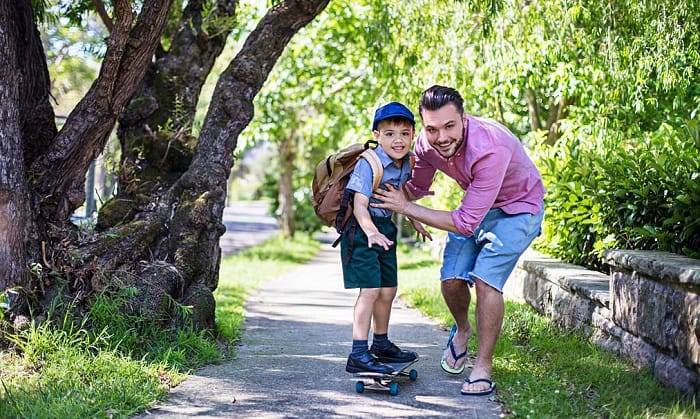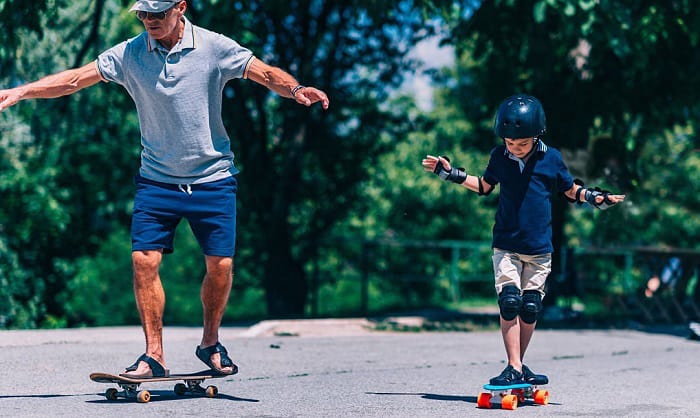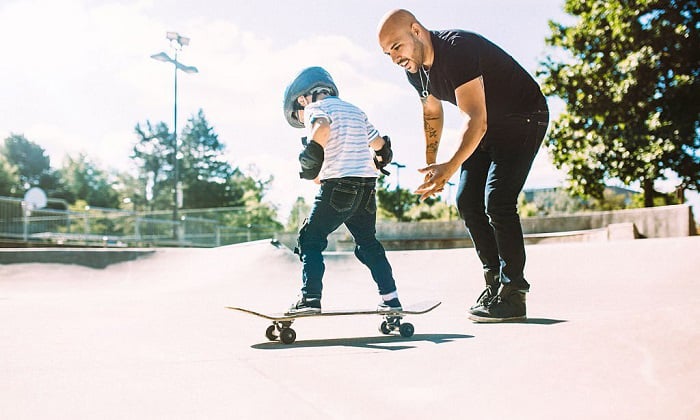Ever wondered how to teach a kid to skateboard? This guide is designed specifically for new skateboarders and their parents, and it will serve as an introduction to the fundamentals of skateboarding. Skating can be a lot safer for kids if you start right. It will also be easier and more enjoyable if you know what you’re doing.
Let me give you a quick rundown on how to ride a skateboard for kids in this article. I’ll start with some very basic riding fundamentals, and familiarize you with how to help children learn skateboard tricks, pushing, and practice tips. Because this is a basic guide, don’t expect anything too complicated.
Table of Contents
Things You’ll Need
Did you know more than 47,000 skating injuries were sustained by young adults (15-24 years old) in 2017? As with any sport, safety is pivotal in skateboarding.
Listed below are the things you’ll need to have a smooth ride and safe practice with your kid.
- Helmet – Skateboarding necessitates the use of a helmet for safety reasons. Its sole purpose is to protect your head if you fall. Beginners, like kids skateboading, are prone to concussions and other brain injuries.
- Skate Pads – Using skateboarding pads to guard your knees and elbows allows you to skate for longer periods with greater confidence.
- Skateboard Shoes – Skateboard shoes, in addition to being more durable and providing a better grip, are not typically intended for everyday walking. Rather, they are designed for solo skating.
- High-Quality Skateboard – To offer that “pop”, also known as the proper balance of flexibility and stiffness, a high-quality skateboard deck is needed. It should be lightweight and durable but also allows riders to react during ollies and other tricks where the deck may come off the ground.
It is said that the top-rated beginner skateboard for kids is the SkateXS, which was created specifically for kids, including 7-year-old children who are just learning to skate.
4-year-old children should be fine with a standard-size board, but we suggest that they use a toddler skateboard with handle. The handle system initially puts you, the parent, in control while still allowing your child to learn how to skateboard.
Step-by-Step Guide
Generally speaking, children under the age of five should not be taught to skateboard because their bodies aren’t yet prepared to handle the stress. But like nearly any sport, there’s no perfect age to get them started.
When there’s a kid on a skateboard, you should keep a close eye on them and be present at all times. Unfortunately, they may do stunts their bones and muscles cannot handle.
Your child is a typical human being, and we don’t want to rush anything because of that.
Step 1: The Proper Stance
The first step to consider is the stance of your kid. There are two kinds of stance: goofy and regular. The goofy stance is where you stand on your skateboard primarily using your right foot, while the regular-footed one puts the left foot on the board. Consider these three basic steps for your kid:
- A kid skateboarding must learn to stand on the skateboard using a comfortable position and stance.
- To maintain balance, teach them to bend their knees.
- See if your kid is balancing right. If not, change the position, whether it may be goofy or regular, to see which one fits.
Once those three points are done, it allows kids to move in any direction while sustaining their balance. This stance gives them a low center of gravity that allows them to do so.
Remember, every person has their natural stance or position: It’s like using a pen, either you are left-handed or right-handed.
Step 2: Begin Practicing on a Piece of Grass or Cuts of Carpet
After your kid learns how to balance and determine their stance, it’s time to practice on grass. First off, place the skateboard on the grass then ask them to stand on the skateboard in a proper position.
Then, ask them to lean to the left as well as to the right. Do this a few times, until they can lean without falling.
The grass is the applicable surface for this type of practice, as even if children fall, it won’t cause any bruises on them.
Step 3: The Key to Pushing
Pushing is a fundamental aspect of skateboarding. So after your kid learns how to balance and maintain their stance, it’s time for a little pushing.
We know that your kid may be excited to do cool tricks, but humbly explain to them how to push efficiently.
The key to doing a good push is to push with the back foot while the front foot is firmly on the skateboard.
First, guide kids in pushing forward and tell them to go slowly. Let him/her stroll around for a while.
If you notice that they kept falling, you may opt to get back to step 2. Everything is all about patience, as playing any sport requires extended practice.
Make an Effort to Skateboard Together
Many kids out there want to learn skateboarding, so they opt to watch videos on Youtube and other platforms. Luckily, your kid can learn with you. Two brains are better than one, and your presence can help prevent your child from sustaining injuries.
We suggest skateboarding teaching once or twice a week. It’s a great parent-child bonding activity, too.
Helpful Tips
- Be mentally prepared
We’ll say it: Your child will fall. They will be injured. They won’t be seriously hurt, but they will get a few scrapes and bruises along the way. They’ll fall off their skateboards just like they fall off their bikes (or out of trees or off the swingset)! It’s unavoidable.
Because you are your child’s role model, you must maintain a calm and confident demeanor throughout this learning process.
If you panic every time they fall off their skateboard, they will panic as well and be afraid to get back on. Be prepared for your child to look to you for praise and encouragement.
Maintain a positive attitude toward learning new skills and provide positive feedback. When kids are determined and encouraged, they’ll be amazed at how quickly they’ll be able to brush off falls.
Conclusion
How to teach a kid to skateboard? Bring your board and demonstrate each step while you teach your child. Together, you and your child can have quality time and be healthy at the same time with this fun activity.
Also, remember that it’s okay to fall! That’s why you must make sure children don’t let setbacks deter them. Keep up with those words of affirmation while you assist them in any way you can, and they will get the hang of skating in no time.
We hope we’re able to provide you with the information you need.

Hi, I am Charles Harris. I opened this site to write as much as I can about my biggest passion – skateboarding!
I started as a clumsy yet passionate rookie 10 years ago to now a still passionate yet much better skateboarder! But I have to tell you, the whole journey has always been fun and rewarding, indeed not without hardship.




